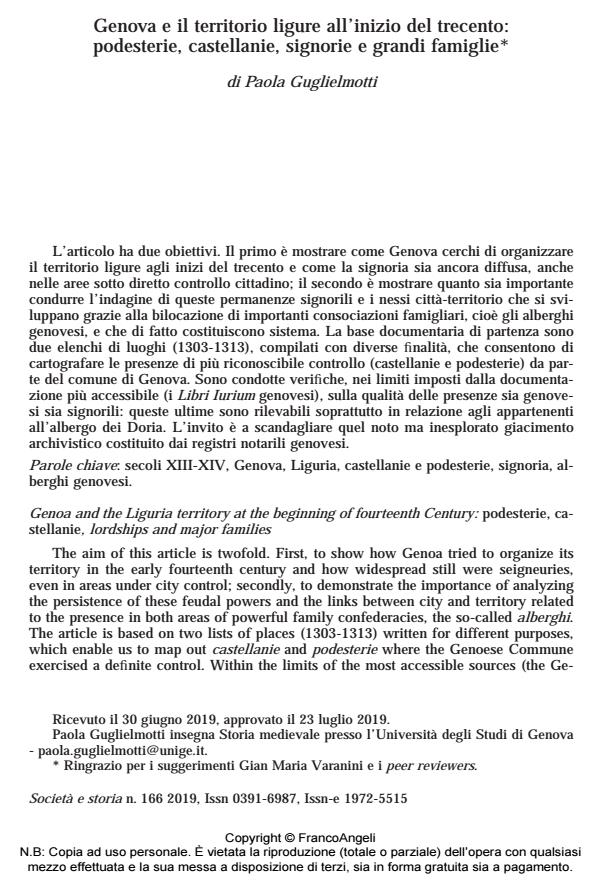Genoa and the Liguria territory at the beginning of fourteenth Century: podesterie, castellanie, lordships and major families
Journal title SOCIETÀ E STORIA
Author/s Paola Guglielmotti
Publishing Year 2020 Issue 2019/166
Language Italian Pages 32 P. 703-734 File size 145 KB
DOI 10.3280/SS2019-166002
DOI is like a bar code for intellectual property: to have more infomation
click here
Below, you can see the article first page
If you want to buy this article in PDF format, you can do it, following the instructions to buy download credits

FrancoAngeli is member of Publishers International Linking Association, Inc (PILA), a not-for-profit association which run the CrossRef service enabling links to and from online scholarly content.
The aim of this article is twofold. First, to show how Genoa tried to organize its territory in the early fourteenth century and how widespread still were seigneuries, even in areas under city control; secondly, to demonstrate the importance of analyzing the persistence of these feudal powers and the links between city and territory related to the presence in both areas of powerful family confederacies, the so-called alberghi. The article is based on two lists of places (1303-1313) written for different purposes, which enable us to map out castellanie and podesterie where the Genoese Commune exercised a definite control. Within the limits of the most accessible sources (the Ge noese Libri jurium), an inquiry has been made into the nature of both communal and feudal authorities, the latter especially in connection with the Doria albergo. Scholars are invited to delve further into the Genoese notarial records, which have so far been hardly explored in this perspective.
Keywords: 13th-14th Centuries, Genoa, Liguria, castellanie and podesterie, lordship, Genoese alberghi.
- La signoria rurale nell’Italia del tardo medioevo. 3 L’azione politica locale Federico Del Tredici, pp.151 (ISBN:978-88-5518-426-7)
- I signori della collina. I Fieschi a Genova nel XIV secolo: strategie cittadine di una famiglia aristocratica Simone Lombardo, in SOCIETÀ E STORIA 177/2022 pp.419
DOI: 10.3280/SS2022-177001 - La signoria rurale nell’Italia del tardo medioevo. 4. Quadri di sintesi e nuove prospettive di ricerca Maria Ginatempo, pp.189 (ISBN:979-12-215-0187-2)
- La signoria rurale nell’Italia del tardo medioevo. 4. Quadri di sintesi e nuove prospettive di ricerca Paolo Buffo, pp.51 (ISBN:979-12-215-0187-2)
Paola Guglielmotti, Genova e il territorio ligure all’inizio del trecento: podesterie, castellanie, signorie e grandi famiglie in "SOCIETÀ E STORIA " 166/2019, pp 703-734, DOI: 10.3280/SS2019-166002